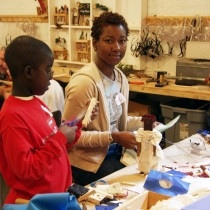Hands-on learning at the Eli Whitney Museum
At the Eli Whitney Museum, learning happens in the workshop.
 |
| Students working on a project at the Eli Whitney Museum. Image Source: Eli Whitney Museum. |
Eli Whitney is most often remembered as the inventor of the cotton gin and a proponent of interchangeable parts, the manufacturing standard that helped usher in the Industrial Revolution. Less well known, though critical to his success as a manufacturer, is how he taught his workers how to craft tools and other artisan skills needed for his factories. Today, this legacy of workshop education is carried on by the Eli Whitney Museum.
For more than 30 years, the Eli Whitney Museum has been a place for young people to build, tinker, and experiment. A wide range of programs are offered for students after school and during vacations, and the apprentice program for high schoolers has been an incubator for high-achieving designers, builders, and computer engineers.
"Education happens both inside and outside the classroom, and it turns out many people are more adept at learning in the workshop than with books," said Executive Director Bill Brown. "In classrooms learning is directed by an expert. But in the real world, there are a lot of circumstances where no one is there telling you the answers and you have to figure out how to solve problems on your own. We happen to like good learners."
The apprentice program has seen its students go on to top universities and colleges, including several to the Massachusetts Institute of Technology. One apprentice, who dropped out of high school in tenth grade in order to spend more time learning computer engineering, is now the head of Harvard University's computer network, according to Brown.
"We've had a lot of kids going on to the pinnacle of achievement," Brown said.
At the inception, the Eli Whitney Museum founders had planned to create a museum highlighting the history of gun manufacturing in New Haven. But after the museum was unable to acquire the Winchester collection, the founders realized that they would not attract enough visitors to the historic site to keep the doors open. So they turned their focus to education, and the workshop-based programs have since evolved to become a destination for thousands of area students.
The Eli Whitney Museum now earns about three-quarters of its revenue from its education programs. Its annual appeal, The Leonardo Project, has its celebration on Thursday, April 28th. Funds at The Community Foundation for Greater New Haven have also supported programs, including the recent project, "Defining Whitneyville," which used signage and exhibits to highlight the historical significance of its site and of Eli Whitney's legacy.
In addition to education programs, the Museum stages exhibits, including collections from the New Haven toy manufacturer Alfred Gilbert, creator of the Erector Set.
For more information, visit the Museum's giveGreater.org profile.
Did you know?
Eli Whitney was 33 years old when, on June 14, 1798, he signed a contract with the U.S. government to produce 10,000 muskets in just two years. Although he was famous for inventing the cotton gin, Whitney had no factory, no gunsmiths, and had never before produced a musket prior to winning the contract.
Source: The Eli Whitney Museum.
